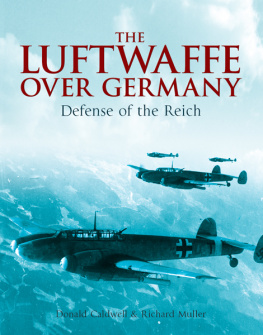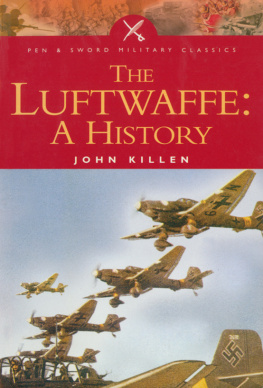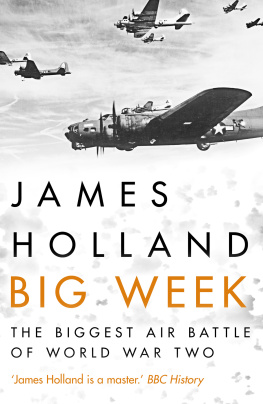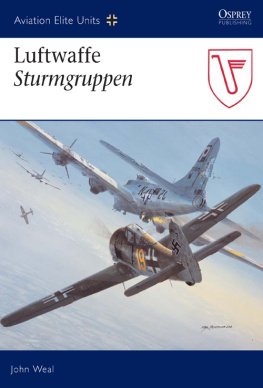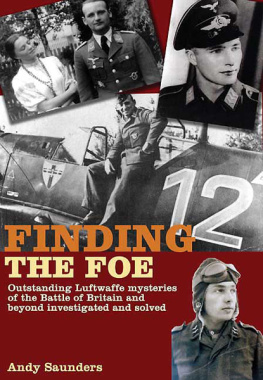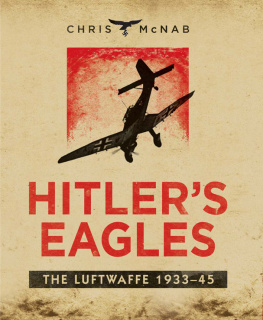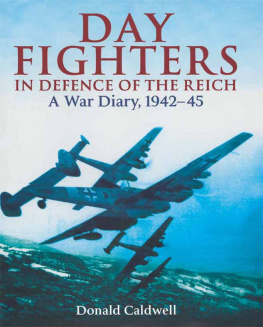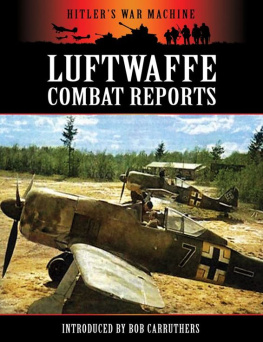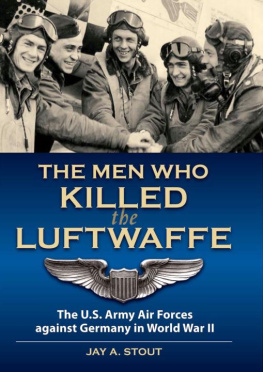A Greenhill Book

Greenhill Books
First published in Great Britain in 2007 by
Greenhill Books, Lionel Leventhal Limited
www.greenhillbooks.com
This edition published in 2014 by
Frontline Books

an imprint of
Pen & Sword Books Ltd
47 Church Street
Barnsley, South Yorkshire
S70 2AS
Copyright Donald Caldwell and Richard Muller, 2014
The right of Donald Caldwell and Richard Muller to be identified as the authors of this work has been asserted by them in accordance with the Copyright, Designs and Patents Act 1988
ISBN 978-1-84832-741-2
PDF ISBN: 978-1-47389-697-0
EPUB ISBN: 978-1-47389-696-3
PRC ISBN: 978-1-47389-695-6
All rights reserved. No part of this publication may be reproduced, stored in or introduced into a retrieval system, or transmitted, in any form, or by any means (electronic, mechanical, photocopying, recording or otherwise) without the prior written permission of the publisher. Any person who does any unauthorized act in relation to this publication may be liable to criminal prosecution and civil claims for damages.
CIP data records for this title are available from the British Library
For more information on our books, please visit
or write to us at the above address.
Printed and bound by CPI Group (UK) Ltd, Croydon, CR0 4YY
CONTENTS
ACKNOWLEDGEMENTS
The history of the Luftwaffe, although a subject of great inherent interest, has posed an almost insur-mountable challenge to serious historians owing to a grievous lack of primary documentation. Some was lost as a result of bomber raids on Luftwaffe head-quarters in Berlin. Most of the records of the combat units were destroyed deliberately, burned by order of the High Command just before the surrender. It has been estimated that 95 percent of the records were lost. Many valuable documents have since turned up: in the personal effects of pilots who refused to turn over their logbooks to be burned, in the files of various Allied agencies, and even found in the German archives themselves. But the data needed for this book, especially the details of combat operations, had to be pulled together and reconciled from hundreds of sources, many of them private archives maintained by the small band of Luftwaffe historians and enthusiasts. A computer with a good database program is the sine qua non for this type of research (thanks, Appleworks!).
Pride of place in any list of individuals to whom we owe our gratitude must go to the Luftwaffe veterans, whose numbers are unfortunately but inevitably growing fewer by the year. Those who provided material for this volume during our ten years of independent data-gathering and, after joining forces, ten years of writing were: Willi Andiel, Hans Berger, Karl Boehm-Tettelbach, Hans-Ekkehard Bob, Walter Bohatsch, Oskar Bsch, Hans Bott, Hermann Buchner, Eberhard Burath, Josef Brschgens, J. E. Clade, Martin Drewes, Georg-Peter Eder, Gnther Ehrlich, Fritz Engau, Wolf Falck, Richard Franz, Adolf Galland, Georg Genth, Heinz Gomann, Alfred Grislawski, Klaus Hahn, Alois Hhn, Hans-Joachim Jabs, Robert Jung, Jrg Kiefner, Otto Kleinert, Gerhard Kroll, Heinz-Gnter Kuring, Erwin Leykauf, Fritz Marktscheffel, Wilhelm Mittag, Werner Molge, Theo Nau, Johannes Naumann, Karl-Heinz Ossenkop, Dietrich Peltz, Horst Petzschler, Douglas Pitcairn, Gnther Rall, Willi Reschke, Arno Rose, Wolfgang Schenck, Ernst Scheufele, Dieter Schmidt-Barbo, Gerhard Schpfel, Ernst Schrder, Erich Schwarz, Gnther Sinnecker, Georg Spies, Peter Spoden, Otto Stammberger, Heinrich Staniwoga, Karl-Heinz von den Steinen, Fritz Ungar, Willi Unger, Hans Weik, Berthold Wendler, Gerd Wiegand, Gnther Wolf, Helmut Zittier, and Paul Zorner.
The families of deceased veterans Otto Behrens, Gerhard Herzog, and Heinz Rose also provided photographs and information.
Our thanks go to the following American and Canadian airmen for their cooperation: William Binnebose, Kenneth Blyth, Ed Burford, Harry Coleman, Arthur Fiedler, Robert Goebel, Al LaChasse, Steve Pisanos, Robert Seelos, and Hubert Zemke.
The fraternity of airwar historians and enthusiasts helped us with generous gifts of time, information, leads, photographs, documents, and/or photographic assistance. We wish to acknowledge: Arno Abendroth, Bernd Barbas, Nick Beale, John Beaman, Paul Berg, Dnes Bernd, Christer Bergstrm, Tami Davis Biddle, Steve Blake, Winfried Bock, Manfred Boehme, Andreas Brekken, David Brown, Eric Brown, Edwina Campbell, Carl Charles, Steve Coates, James Corum, Jerry Crandall, A. J. Cranston, Jim Crow, Curt Deatrick, Arie De Jong, Ivo De Jong, Wim de Meester, Russ Fahey, Bob Fletcher, Stephen Fochuk, John Foreman, Jim Forsyth, Robert Forsyth, Norman Franks, Garry Fry, R. B. Gill, Steve Gotts, Richard Goyat, Timothy Gravelle, John Gray, Lewis Griffith, Russell Guest, Ian Hawkins, Bill Hess, Larry Hickey, Michael Holm, Kevin Holzimmer, Budd Jones, Peter Kassak, Jim Kitchens, Werner Kock, Malcolm Laing, Gerd Lanio, Jean-Yves Lorant, John Manrho, Lex McAulay, Ian McLachlan, Michael Meyer, Robert Michulec, Kenneth Minor, Kees Mol, Eric Mombeek, George Morrison, Williamson Murray, Wesley Newton, Frank Olynyk, Neil Page, Robert Peczkowski, Doug Peifer, Gordon Permann, Jim Perry, Toni Petito, Peter Petrick, Dick Powers, Alfred Price, Jochen Prien, Lorenz Rasse, Jean-Louis Roba, Barry Rosch, Brown Ryle, Chris Shores, Barry Smith, Evelyn Smith, Sam Sox, Klaes Sundin, Gnter Sundermann, Lothair Vanoverbeke, John Vasco, Luc Vervoort, Dave Wadman, Edward Westermann, and Tony Wood. We apologize to anyone whose name has been inadver-tently omitted from this list.
The Bundesarchiv-Bildarchiv (Koblenz) and ww2images.com have granted permission to reprint photographs from their collections. We also greatly appreciate the following publishers and authors for kindly granting permission to reproduce quoted passages from published works: W. W. Norton for Bert Stiles, Serenade to the Big Bird; the British National Archives (Public Record Office) for Air Ministry, The Rise and Fall of the German Air Force and Denis Richards, Royal Air Force 19391945; Ian Allan Publishing for Armand van Ishoven, Messerschmitt Bf 109 at War; and author Eric Mombeek for Defending the Reich: The History of Jagdgeschwader 1 Oesau.
We wish to acknowledge the help given us by the professional staffs of the British Public Record Office, the Bundesarchiv-Militrarchiv (Freiburg), the Lake Jackson Public Library, the Auburn University Library, the Military Archives Division of the U.S. National Archives, the Air University Library, the Air Command and Staff College, the School of Advanced Air and Space Studies, and the United States Air Force Historical Research Agency.
A special thanks is owed to Les Butler for the maps and figures.
Last but by no means least, our thanks go to our wives for their patience and support.
Any book of this size and scope will contain errors of both omission and commission. We welcome corre-spondence with anyone who has information to share pertaining to this fascinating period in aviation history. We wish to state further that all quotations in the book that were originally written or spoken in the German language were translated into English by one of us, with the exception of those identified as wartime or postwar Allied official translations. The responsibility for any consequent errors in fact or tone is our own.
PREFACE
From September 4, 1939, through the end of the war in Europe in May 1945, the Luftwaffes day-fighter force struggled to defend German airspace against enemy attack, first by the Royal Air Forces Bomber Command, and later by the four-engine bomber fleets of the United States Army Air Forces (USAAF). The battle to defend the homeland was not one the Germans planned to fight, yet by 1944 it had evolved into a titanic campaign involving thousands of aircraft, Flak guns, sophisticated radar and fighter-control equipment, and highly trained personnel. In the process, the German day-fighter arm was shattered, leaving the combat fronts stripped of air cover. By any measure, the aerial defenders of the Reichthe
Next page
